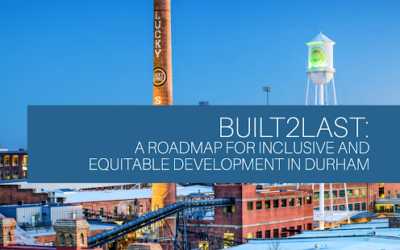Commentary: Policies Hamstring Federal Investment in Rural Small Businesses
The small-business program in USDA can’t leverage good rates and loan guarantees the way the national small-business program can. That’s one reason that the rural program has established only a handful of business investment companies since its authorization in the 2002 Farm Bill.
View of the U.S. Department of Agriculture (USDA) Headquarters Whitten Building. USDA Photo by Preston Keres
The Covid-19 pandemic has dealt a devastating blow to America’s small businesses, especially those in rural America.
Long before the pandemic, rural small businesses were constrained by lack of access to capital and other challenges, most notably geographical isolation and inadequate broadband. These problems are magnified today as major disadvantages in the race to secure lifeline funding from the federal CARES packages and other small business assistance programs.
With appropriate modifications, there is an existing federal program that can serve as an additional reliable source of capital for small businesses in rural America. There are proposed regulations in the works that could increase investment and lending in rural America.
The federal government is the original investor in small business. In 1958, Congress established the Small Business Investment Company (SBIC) program as a mechanism for small business access to long-term capital for start-up, expansion, or recovery. Licensed by the Small Business Administration (SBA), these privately owned investment companies help small businesses with both equity and debt financing. Leveraging favorable rates and an SBA loan guarantee, SBICs have successfully invested billions of dollars in more than 100,000 businesses in a broad range of industries. According to A December 2019 Congressional Research Service report, one half of SBIC financing has gone to firms in either manufacturing (25.8%) or professional, scientific and technical services (14.6%).
Recognizing the challenges that rural small businesses face, a Rural Business Investment Company (RBIC) program was established within the U.S. Department of Agriculture (USDA) in the 2002 Farm Bill to promote developmental venture capital. Eighteen years later, the key difference is that the federal leverage is not available for the RBIC program as it is for the SBIC. So, while there are more than 300 SBICs to invest in small businesses through the Small Business Administration, only seven RBICs have been created through USDA to invest in rural small businesses. The RBIC program lack of federal leverage to get better interest rates and federal loan guarantees severely limits the creation of new RBICs to address the capital access problem of small businesses in rural America.
Banks have an incentive to invest in SBICs and RBICs through the Community Reinvestment Act of 1977 (CRA). While intended to work equally well in urban and rural areas, leveraging CRA in rural areas has proven to be more challenging. The reach of the CRA (originally focused primarily on urban neighborhoods) was refined in 2005 to include activities that revitalize or stabilize distressed or underserved communities in middle-income rural America. But the potential impact of CRA is nullified by the continuing loss of branch banks in rural areas. According to a 2019 Federal Reserve report, 800 rural counties (just over 40 percent) lost 1,533 branch banks from 2012 to 2017. Some of the rural counties experienced considerable declines in bank branches over those five years, and those counties were generally poorer, had residents with fewer years of education, and a greater proportion of African American residents relative to other rural counties. These public-private partnerships offer banks a competitive asset class and help them meet their regulatory requirements of the CRA. The challenges of branch bank loss and lack of investment in broadband were stressing rural America before this pandemic and may now bring it to its knees.
Lincoln called USDA, “the People’s Department,” but rural people are getting the short end of the stick in terms of small business investment that can be leveraged now. If we want rural America and its people to have equity, we must include a federal leverage for the RBICs just like the SBICs. After all, it funds are lent and repaid. The SBIC program has been so successful that the American Recovery and Reinvestment Act of 2009 (ARRA) included an increase in the amount of leverage available in the SBIC program by increasing the maximum amount and encouraging SBIC investment in smaller businesses, aiding in recovery of small businesses post-Great Recession.
What we need right now is more, not less, opportunity for public-private leverage to save small businesses through successful investment programs that already exist. Revamp CRA regulations sooner rather than later. The story of rural America has been one of economic decline coupled with an aging and shrinking population. Rather than allowing the pandemic to further hollow out Rural America, we have the tools to expand access to capital to the heart of the country so rural small businesses can create new domestic supply chains and innovators can provide affordable access to broadband. Proposed new CRA regulations are currently under review but in the interim, CRA investment in RBICs and increased investment and lending for broadband infrastructure and adoption as a qualified CRA activity are two activities that could be encouraged to help rural America.
Related Articles
Business Intelligence for Creating an Inclusive Model of Contracting and Procurement in the City of Durham
Gentrifying cities increasingly are adopting inclusive and equitable development policies, strategies, tools, and regulatory practices to minimize, if not altogether eliminate, the demographic and economic dislocations that often accompany their growing attractiveness as ideal places to live, work, and play for a creative class of young people and well-resourced retirees who are predominantly white. Creating greater opportunities for historically under-utilized businesses to grow and prosper through enhanced local government contracting and procurement is one mechanism through which gentrifying cities are trying to generate greater equity and shared prosperity.
Built 2 Last: A Roadmap for Inclusive and Equitable Development in Durham
A roadmap for inclusive and equitable development will increase shared prosperity in Durham: sustainability scorecard; collective ambition community mobilization strategy; inclusive entrepreneurial/ business ecosystem; and equitable community economic development innovations fund.
South Carolina Community Capital Alliance Case Study
In the state of South Carolina, community development practitioners have a history of organizing to capitalize on opportunities to create practical solutions for the state’s low- and moderate- income communities in both urban and rural areas. The statewide Community Development Corporation (CDC) association was founded in 1994 by four CDCs. And, in 2000, the state General Assembly provided $10 million in grants, loans and tax credits to certified CDCs by enacting a Community Economic Development Act. The legislation required a state certification of entities as CDCs and CDFIs. Even though CDFIs may be certified by the U.S. Treasury, the state of South Carolina is separate and apart from that process.








